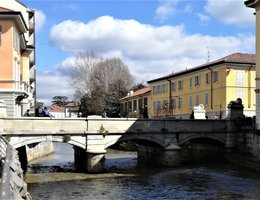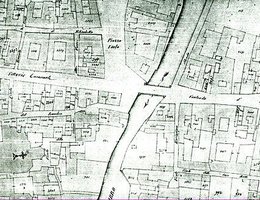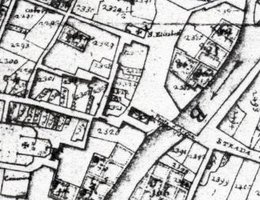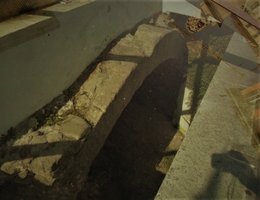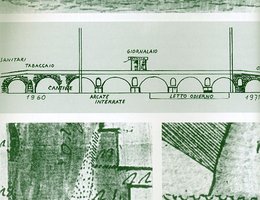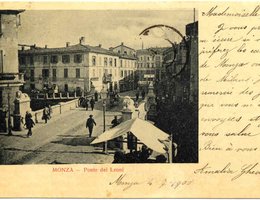di Lo Russo Francesco
Il ponte di Arena fu costruito in età romana, ma nel XIX secolo si pensava fosse di età medioevale, e fu distrutto nel 1838 per creare lo spazio necessario alla realizzazione dell’attuale Ponte dei Leoni, il cui completamento avvenne nel 1842 in occasione dell’apertura della via Ferdinandea (oggi via Vittorio Emanuele) come ingresso monumentale alla città.
Il ponte antico era composto da 8 arcate, che, come erano solite essere costruite in età romana erano ribassate, come si può vedere anche nel ponte Fabricio a Roma. L’attuale ponte dei Leoni invece ne ha solo 3.
Fu costruito sul decumano, mentre il cardo era costituito dall'attuale via San Martino. Ciò che rimane dell’antica costruzione è tutt’ora visibile e si trova sotto una teca e sotto le fondamenta di alcuni edifici vicini.
Inizialmente il Ponte di Arena era lungo 70 metri ed era chiamato così poiché si trovava nella contrada che era detta d'Arena e costituiva il punto di attraversamento del fiume Lambro per i traffici commerciali diretti a nord. Inoltre fu chiamato d'Arena a causa dei frequenti depositi di sabbia in quella zona da parte del fiume.
Nel '700 la mappa del catasto teresiano ci mostra lo stretto ed antico ponte d'Arena che, appena superato il Lambro, si apriva a destra sulla piazza Grande, che sul fondo terminava col Seminario. A sinistra il ponte d'Arena dava sul vicolo che poi, passando sotto la torre, giunge a piazza del Duomo.
Non vi era continuità verso il palazzo dell'Arengario (non esisteva neppure l'attuale piazza Roma).
Una mappa del 1857, invece, ci presenta una situazione molto simile a quella attuale: il ponte dei Leoni è realizzato e così con la nuova via Vittorio Emanuele verso l'Arengario, dove ancora l'isolato del Pretorio non è stato sfondato per realizzare piazza Roma.
Da una parte questo “grande asse” centrale est-ovest della città “mirava” il palazzo dell'Arengario, dall'altra la facciata della chiesa di San Maurizio che poi fu demolita.
La costruzione dell’attuale ponte durò dal settembre 1838 e terminò nel 1842 e fu uno dei primi ponti ad essere illuminato da luce a gas, con quattro lanterne per ogni angolo.
I lavori si protrassero fino al 1840. Costruito per esaltare la forza e il potere dell’impero austriaco, si compone di tre arcate con spallette in granito. Ai quattro angoli si trovano quattro leoni in marmo di Carrara, opera dello scultore milanese Antonio Tantardini, realizzate agli inizi della sua attività artistica. Il disegno del ponte è opera dell’ingegner Caimi; la sua costruzione venne invece affidata per asta al capomastro Bardelli per la somma di 71.400 lire che comprendevano anche la cessione dei materiali del vecchio ponte d’Arena.
ENGLISH VERSION
The Arena bridge was constructed during the Roman period, but in the 18th century it was believed a medieval architecture. It was destroyed in 1842 to make space for the new bridge, the Ponte dei Leoni, which was completed in 1842 with the opening of the via Ferdinandea (today called via Vittorio Emanuele) as a monumental entrance to the city. The antique bridge was composed of 8 arches. Following a Roman typical structure, the arches were quite low, as we can clearly see in another architecture, the Fabricio bridge in Rome. Today, the Ponte dei Leoni only retains 3 arches. It was built on the decumanus, while the cardo corresponded to the modern via San Martino. What remains of the antique bridge is visible through a glass and at the foundation of some buildings nearby. Initially the bridge was 70 meters long. It was called Ponte di Arena because it was located in the Arena district. In addition, the name might refer to the sand sediments left in that area by the river. The bridge crossed the Lambro river and facilitated the commercial business with the north. In the eighteenth-century map of the Catasto Teresiano, a census of the lands, shows the narrow and ancient bridge of the Arena. The bridge opened on the right on Piazza Grande, with the seminary at the end of the street. On the left of the bridge, there is a street that reaches Piazza del Duomo. A map of 1857, presents a very similar situation to the way the bridge look today: the Ponte dei Leoni was constructed as well as Via Vittorio Emanuele. Via Vittorio Emanuele is oriented towards the Arengario, where the block of the Pretorio is still visible. Later it will be demolished to make space for Piazza Roma. This main east-west axis of the city pointed towards the Arengario palace on one side, and on the other to the facade of San Maurizio, which was later demolished. The construction of the bridge lasted 2 years, from 1838 to 1840, and it was one of the first bridges to be illuminated with gas light, having four lanterns on each corner. The bridge was built to enhance the power of the Austrian empire. A bridge with three arches, decorated at the corners with four lions made of Carrara marble, realized by the Milanese sculptor Antonio Tantardini in his early career. The bridge was designed by the engineer Caimi and it costed around 71.400 lire.
BIBLIOGRAFIA
